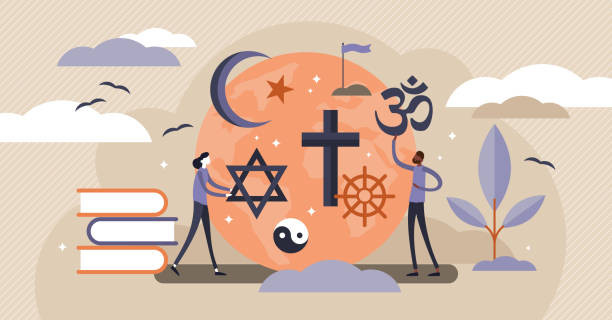What are their key teachings and practices?
By Hugo Keji
Christianity-
Key Teachings:
The Trinity: Belief in one God in three persons – Father, Son (Jesus Christ), and Holy Spirit.
Salvation through Jesus Christ: Jesus' death and resurrection provide the means for human salvation and eternal life.
Love and Forgiveness: Emphasis on loving God and others, forgiveness of sins, and living a moral life.
The Bible: Sacred scripture consisting of the Old Testament and the New Testament, providing spiritual guidance and teachings.
Practices:
Prayer and Worship: Regular personal and communal prayer, worship services, especially on Sundays.
Sacraments: Key rituals such as Baptism and Holy Communion (Eucharist).
Reading the Bible: Study and reflection on scriptures.
Charity and Service: Acts of kindness, helping the needy, and community service.
Islam-
Key Teachings:
Tawhid (Monotheism): Belief in the oneness of Allah.
Prophethood: Muhammad is the final prophet in a line of prophets including Adam, Noah, Abraham, Moses, and Jesus.
Five Pillars of Islam: Core practices that shape a Muslim's faith and actions.
Quran: The holy book revealed to Muhammad, serving as the ultimate guide for Muslims.
Practices:
Shahada: Declaration of faith in the oneness of Allah and the prophethood of Muhammad.
Salat: Performing ritual prayers five times a day.
Zakat: Giving alms to the poor, typically 2.5% of one’s savings.
Sawm: Fasting during the month of Ramadan.
Hajj: Pilgrimage to the holy city of Mecca, required once in a lifetime if possible.
Hinduism-
Key Teachings:
Dharma: Duty, righteousness, and moral law governing individual conduct.
Karma: Law of cause and effect where actions determine future outcomes.
Moksha: Liberation from the cycle of rebirth (samsara) and union with Brahman.
Various Paths to Spirituality: Bhakti (devotion), Jnana (knowledge), and Karma (action).
Practices:
Puja: Ritual worship of deities, performed at home or in temples.
Meditation and Yoga: Practices to achieve mental discipline and spiritual insight.
Festivals: Celebrations like Diwali, Holi, and Navaratri.
Pilgrimage: Visits to holy sites such as Varanasi, Rishikesh, and the Kumbh Mela.
Buddhism-
Key Teachings:
Four Noble Truths: Core principles that
outline the nature of suffering and the path to its cessation.
Eightfold Path: Guidelines for ethical and mental development leading to enlightenment.
Nirvana: Ultimate goal of ending the cycle of rebirth and suffering.
Dependent Origination: Concept that all phenomena arise in dependence on conditions and causes.
Practices:
Meditation: Mindfulness and concentration practices to develop insight and tranquility.
Ethical Conduct: Following precepts such as non-violence, truthfulness, and abstaining from harmful behaviors.
Monastic Life: Many Buddhists, especially monks and nuns, follow a strict lifestyle dedicated to spiritual development.
Rituals and Festivals: Observances like Vesak (Buddha’s birthday) and various local traditions.
Judaism-
Key Teachings:
Monotheism: Belief in one God, Yahweh.
Covenant: The special relationship between God and the Jewish people, marked by agreements like those made with Abraham and Moses.
Torah: Central reference of the religious Judaic tradition, encompassing law, guidance, and teachings.
Ethical Living: Emphasis on justice, charity, and social responsibility.
Practices:
Prayer: Daily prayers, especially communal prayers on the Sabbath and festivals.
Sabbath (Shabbat): Weekly day of rest and worship from Friday evening to Saturday evening.
Dietary Laws (Kashrut): Following kosher dietary rules.
Festivals: Celebrations like Passover, Yom Kippur, Hanukkah, and Rosh Hashanah.
These teachings and practices reflect the core values and spiritual paths of each religion, shaping the lives and beliefs of their adherents.
App link: FREE for download... https://www.amazon.com/dp/...
By Hugo Keji
Christianity-
Key Teachings:
The Trinity: Belief in one God in three persons – Father, Son (Jesus Christ), and Holy Spirit.
Salvation through Jesus Christ: Jesus' death and resurrection provide the means for human salvation and eternal life.
Love and Forgiveness: Emphasis on loving God and others, forgiveness of sins, and living a moral life.
The Bible: Sacred scripture consisting of the Old Testament and the New Testament, providing spiritual guidance and teachings.
Practices:
Prayer and Worship: Regular personal and communal prayer, worship services, especially on Sundays.
Sacraments: Key rituals such as Baptism and Holy Communion (Eucharist).
Reading the Bible: Study and reflection on scriptures.
Charity and Service: Acts of kindness, helping the needy, and community service.
Islam-
Key Teachings:
Tawhid (Monotheism): Belief in the oneness of Allah.
Prophethood: Muhammad is the final prophet in a line of prophets including Adam, Noah, Abraham, Moses, and Jesus.
Five Pillars of Islam: Core practices that shape a Muslim's faith and actions.
Quran: The holy book revealed to Muhammad, serving as the ultimate guide for Muslims.
Practices:
Shahada: Declaration of faith in the oneness of Allah and the prophethood of Muhammad.
Salat: Performing ritual prayers five times a day.
Zakat: Giving alms to the poor, typically 2.5% of one’s savings.
Sawm: Fasting during the month of Ramadan.
Hajj: Pilgrimage to the holy city of Mecca, required once in a lifetime if possible.
Hinduism-
Key Teachings:
Dharma: Duty, righteousness, and moral law governing individual conduct.
Karma: Law of cause and effect where actions determine future outcomes.
Moksha: Liberation from the cycle of rebirth (samsara) and union with Brahman.
Various Paths to Spirituality: Bhakti (devotion), Jnana (knowledge), and Karma (action).
Practices:
Puja: Ritual worship of deities, performed at home or in temples.
Meditation and Yoga: Practices to achieve mental discipline and spiritual insight.
Festivals: Celebrations like Diwali, Holi, and Navaratri.
Pilgrimage: Visits to holy sites such as Varanasi, Rishikesh, and the Kumbh Mela.
Buddhism-
Key Teachings:
Four Noble Truths: Core principles that
outline the nature of suffering and the path to its cessation.
Eightfold Path: Guidelines for ethical and mental development leading to enlightenment.
Nirvana: Ultimate goal of ending the cycle of rebirth and suffering.
Dependent Origination: Concept that all phenomena arise in dependence on conditions and causes.
Practices:
Meditation: Mindfulness and concentration practices to develop insight and tranquility.
Ethical Conduct: Following precepts such as non-violence, truthfulness, and abstaining from harmful behaviors.
Monastic Life: Many Buddhists, especially monks and nuns, follow a strict lifestyle dedicated to spiritual development.
Rituals and Festivals: Observances like Vesak (Buddha’s birthday) and various local traditions.
Judaism-
Key Teachings:
Monotheism: Belief in one God, Yahweh.
Covenant: The special relationship between God and the Jewish people, marked by agreements like those made with Abraham and Moses.
Torah: Central reference of the religious Judaic tradition, encompassing law, guidance, and teachings.
Ethical Living: Emphasis on justice, charity, and social responsibility.
Practices:
Prayer: Daily prayers, especially communal prayers on the Sabbath and festivals.
Sabbath (Shabbat): Weekly day of rest and worship from Friday evening to Saturday evening.
Dietary Laws (Kashrut): Following kosher dietary rules.
Festivals: Celebrations like Passover, Yom Kippur, Hanukkah, and Rosh Hashanah.
These teachings and practices reflect the core values and spiritual paths of each religion, shaping the lives and beliefs of their adherents.
App link: FREE for download... https://www.amazon.com/dp/...
1 yr. ago

